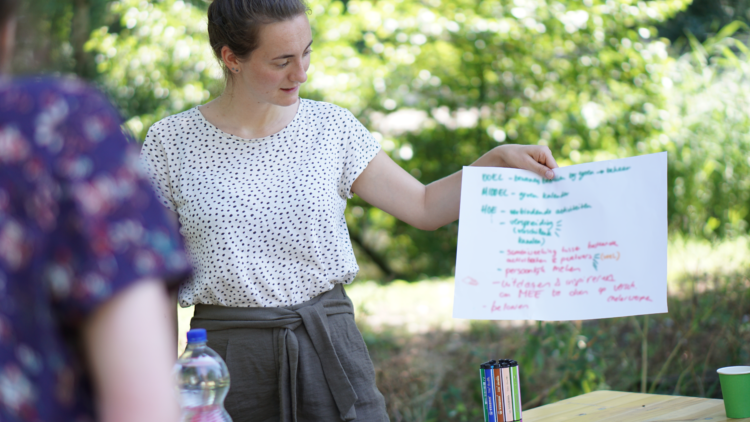A more inclusive approach for the energy transition

‘Using design to create an impact on sustainable and social challenges.’ That is the goal Eva set herself at the start of her graduation project. Sustainability has always been important to her in both her personal life as well as during her studies. As a Master student in Design for Interaction, Eva knew that she wanted to do a final project where the two subjects intersected for a long time.
During her internship at Zeewaardig, Eva learned about the energy transition, specifically the discontinuation of natural gas in Reyeroord. Since 2020, the Reyeroord neighbourhood in Rotterdam has been a testing ground for the national program for gas-discontinuation in neighbourhoods, ‘Programma Aardgasvrije Wijken’ to discover the options for discontinuing gas. District heating seems to be the easiest and cheapest technical solution in this district. Concerning the social aspects of this solution, Rotterdam’s municipality works closely with Service Design Agency Zeewaardig. The agency is involved in designing and implementing strategies to support the information on “Aardgasvrij Reyeroord” communication between the municipality and the residents in the neighbourhood. For example, a campaign, neighbourhood meetings, the website and innovative ways to spread information about gas discontinuation.
Eva contributed to this project by meeting various residents of Reyeroord and collaborating in the first interventions of Zeewaardig. She experienced that reaching residents can be challenging for complex topics like these: ‘Besides sustainable development, the social aspect is equally important. Without the support of citizens, we cannot achieve any climate goals.’
And that’s why it made perfect sense to join the Participatory City Making Lab during Eva’s graduation project: Participation is an essential condition for the energy transition.
An inclusive approach for Zeewaardig
In the Netherlands, sustainability seems to be a topic for a select group of “early adopters”, but ultimately it relates to everyone. This is also true for Reyeroord, where only a selected group of people are involved in activities related to the transition towards natural gas-free houses. In contrast, the eventual transition takes place throughout the entire neighbourhood and thus influences all residents. Therefore, every resident needs to be aware of the changes to come and be allowed to make choices about the changes that likely impact their home environment.
For these reasons, Eva proposes a more inclusive approach to designing interventions for the residents of Reyeroord and evaluates how Zeewaardig can adopt this approach in their design practice. Her assumption is that a more inclusive approach contributes to broader and more diverse participation in the neighbourhood and ensures a fairer energy transition.
Improving through an iterative approach
The biggest challenge of Zeewaardig is the high number of ‘unusual suspects’ in Reyeroord who the local municipality struggles to reach and involve. Therefore Eva has started her research investigating who these unusual suspects could be and which are currently excluded in the neighbourhood development. Through literature research, discussions and experiences from the municipality and Zeewaardig, she found that tenants currently feel very left out in the energy transition because they cannot make adjustments to their home themselves and therefore always miss out on subsidies. Another important group that Eva identified are residents who do not speak Dutch, who are currently excluded because the municipality only sends Dutch newsletters.
Identifying these target groups alone, however, was not enough to help Zeewaardig designers to actually adopt a more inclusive design approach. Therefore Eva also compared their design process with important aspects of inclusivity. One insight she found is that it is difficult to identify who is responsible for an inclusive process; does this responsibility lie with the designers or with the client? In addition, she found that inclusivity is a quality that people can train and become better at if they do it more often. Among others, these insights, in particular, suggested to Eva the need for tools that make expectations and responsibilities negotiable between different stakeholders in a structured way, and that remind designers of inclusivity during their process.
Eva is currently developing such tools through an iterative design process, in close relation with other designers. In particular, her various tools are tested by design master students at IDE, as well as the designers of Zeewaardig. Through frequent and quick iterations Eva can learn even from imperfect prototypes how to gradually improve the tools’ usability, to finally create the most fitting version of the toolkit for designers’ practice.
The first step towards a fairer energy transition
Inclusivity is a complex subject and there is always something more to learn about it. Overall, Eva considers her toolkit as a first step in the right direction and she shares with the Zeewaardig design team the ambition to include and activate more residents for the pilot ‘Reyeroord natural gas-free’. The goal of her project and toolkit is to help designers improve the inclusiveness of their design interventions and enable designers to invite more residents who would usually not be addressed. Ultimately, she hopes the project will contribute to a more effective and fairer energy transition in the future.